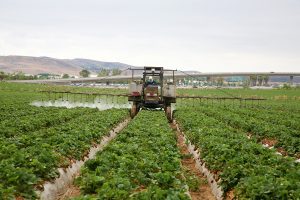If you eat organic fruit and vegetables, you likely are familiar with the dirty dozen among fruit and vegetables. Each year the Environmental Working Group is publishing the latest information about the most polluted fruit and vegetables. Here is the latest 2018 list of the “dirty dozen”.
Regular strawberries make the top of the list. They are receiving a vigorous spraying program several times during the growing season. All of these poisons stay on the surface of the strawberries , when they are ready for harvesting, and the toxins will enter your body.
When I go shopping I am aware of the dirty dozen. Instead I select the somewhat more expensive organic fruit and vegetables in lieu of the “dirty dozen”. 90% of sweet bell peppers show a heavy contamination with pesticides. On the surface they may look beautiful; but why would I want to buy this?
The use of chemicals in farming fruit and vegetables
Pesticides are the common weapon to kill unwanted insects that damage fruit or vegetables. Other chemicals are in use to remove weeds, to treat molds and get rid of rodents. Organophosphates make up about 50% of the insecticides that are sprayed onto crops. They affect the nerves, lead to memory loss, cause a slowdown of reaction time in response to stimuli and more. Particularly children are very sensitive to them.
Here is a review of the use of insecticides by the World Health Organization.
Washing fruit and vegetables to remove insecticides and other chemicals
Washing fruit and vegetables with water or with some added baking soda can remove some of the residual surface chemicals. But there will still be some chemicals that have already migrated below the skin of an apple or into the fruit or vegetable. There is a limit what you can do to clean the dirty dozen. Once a toxin has become systemic in a plant, all the washing in the world will not remove the hazardous substance. The only safe thing is to replace these fruits and vegetables with their organic fruit and vegetables counterparts. The Environmental Working Group has measured the residuals carefully and ordered them by severity of contamination. So, here is the list of the “dirty dozen” by order from the most contaminated to the least contaminated:
Strawberries, spinach, nectarines, apples, grapes, peaches, cherries, pears, tomatoes, celery, potatoes and sweet bell peppers.
The “clean15” guide to produce containing the least insecticide residue
Apart from the dirty dozen for which the Environmental Working Group is famous, they have also produced a list of the 15 least insecticide contaminated crops. This is known as the “clean 15” guide. The cleanest vegetables are avocados, which show only a contamination of 1 % and are very safe to eat. Here are the rest of the safe to eat fruit and vegetables in ascending order: Avocados, sweet corn, pineapples, cabbage, onions, frozen sweet peas, papayas, asparagus, mangoes, eggplant, honeydew melon, kiwi, cantaloupe, cauliflower and broccoli.
There is one other problem to be aware of: in the US corn, papaya and summer squash are on the market, and a large proportion of the crop is genetically modified. In that case your only defense is to buy organic corn, papaya and summer squash.
Conclusion
The “dirty dozen” are the fruit and vegetables that have the highest contamination with insecticide residues. Even washing these crops is not sufficient to remove enough insecticide material making them safe to eat. But you can buy the organic versions of these crops. There is also a guide, which tells you what the 15 safe fruit and vegetables are. Avocado is at the top of the clean list, sweet corn is a close second. In the US it is safer to buy organic sweet corn, because GMO corn is not labelled. The Environmental Working Group has done a good job in watching insecticide contamination for the consumer. Shop wisely to ensure that the produce you eat does not contain hazardous levels of pesticide and insecticide residue. You want to keep your lifetime insecticide exposure down to safe levels where it will not cause adverse health effects.







